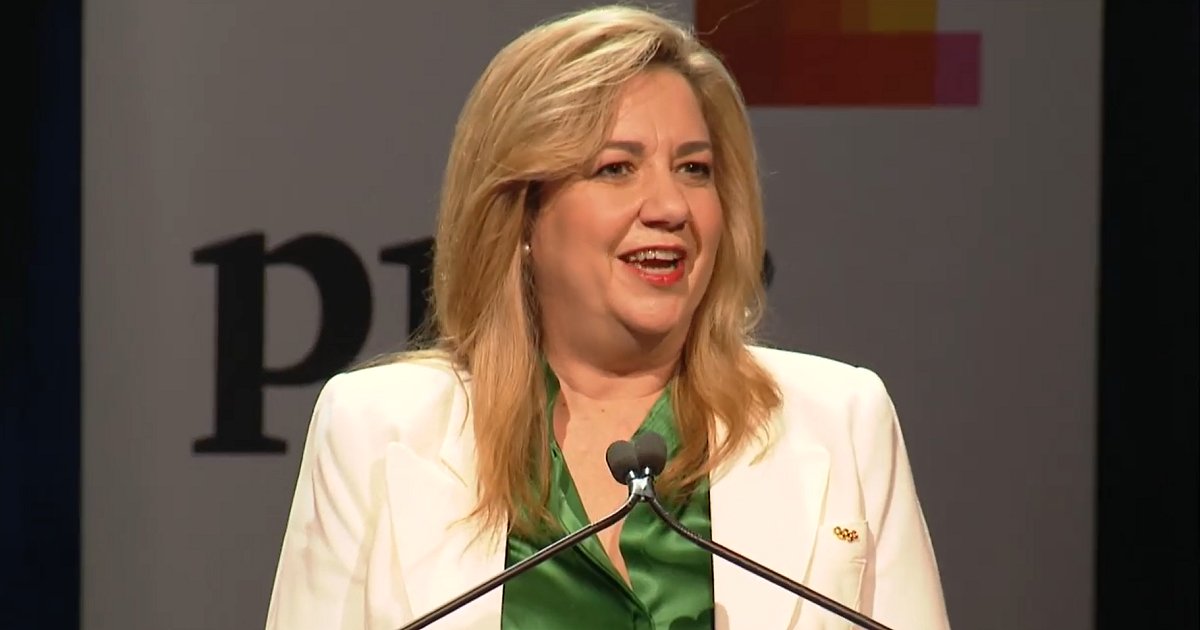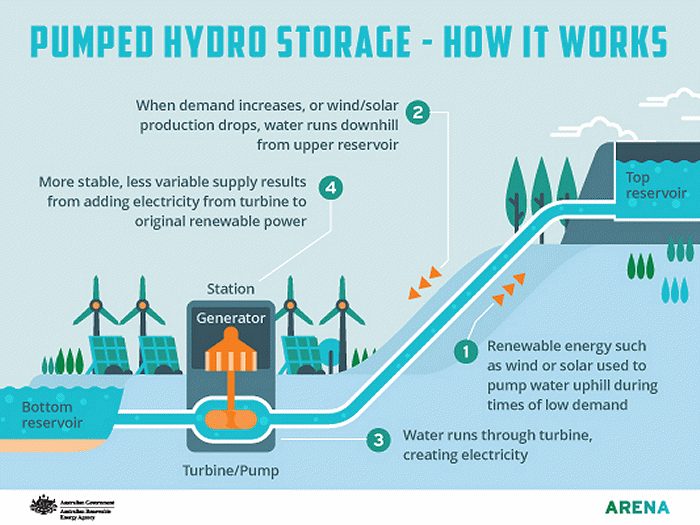
Queensland Premier Annastacia Palaszczuk was pretty pumped about a “bold clean energy future” for Queensland yesterday – particularly concerning the role pumped hydro will play.
Announcing the $62 billion Queensland Energy and Jobs Plan, Premier Palaszczuk said it would mean cheaper, cleaner and secure energy for Queenslanders.
So, What’s In The Plan?
It aims for 70% of Queensland’s energy supply to be sourced from renewables by 2032, and 80% by 2035 – and these targets are to be legislated.
Among the Queensland Energy and Jobs Plan elements:
- Two new huge pumped hydro facilities – one at Pioneer/Burdekin and the other at Borumba Dam by 2035.
- A “SuperGrid” connecting solar, wind, battery and hydrogen generators across the state. The SuperGrid will support 22 gigawatts of new renewables capacity.
- Converting publicly owned coal fired-power stations to clean energy hubs by 20351.
- 100,000 new jobs by 2040, most of which will be in regional Queensland.
- 11.5GW of rooftop solar power and 6GW of embedded batteries.
- Building Queensland’s first hydrogen- ready gas turbine.
11.5GW of rooftop solar is a lot of solar panels. As at the end of June this year, here’s how Queensland’s solar power stats looked (Source: APVI):
- Total Installations: 880,411
- < 10kW systems: 3,450MW capacity
- < 100kW: 1,326MW capacity
- >100kW: 3,436MW capacity
But the >100kW category total isn’t just made up of rooftop solar installations – it also includes solar farms. Take the big ‘uns out and the >100kW system collective capacity is (very roughly) just 156MW. APVI’s figures also don’t take into account any capacity among the smaller-scale systems that has been decommissioned for whatever reason.
What Is Pumped Hydro?
Pumped hydro storage involves the use of surplus, off-peak electricity or renewables based generation such as solar energy to pump water from a lower reservoir to a higher reservoir. When electricity is needed, water from the top reservoir is released, flows through turbines to generate electricity and is discharged into the lower reservoir. Rinse and repeat.
Back in 2017, boffins at ANU identified 22,000+ potential pumped hydro sites across Australia; representing storage capacity of 67,000 gigawatt-hours (GWh). Many of these sites are in Queensland.
The first facility under the Queensland Energy and Jobs Plan will be the Borumba Pumped Hydro project located west of Gympie; with a completion target date of 2030. This project will deliver 2 gigawatts of 24-hour storage.
The second preferred pumped hydro site is 70 kilometres west of Mackay. The Pioneer-Burdekin pumped hydro project (“Battery of the North”) will be the largest pumped hydro energy storage system in the world (at this point), with 5 gigawatts of 24-hour storage and the potential for stage 1 to be completed by 2032.
“By 2032 when stage one of the Battery of the North is expected to come online, we will be at 70 per cent renewable energy,” said Premier Palaszczuk. “By 2035 Queensland when stage two comes online we will have no regular reliance on coal and be at 80 per cent renewable energy.”
Premier Palaszczuk’s full outline of the Queensland Energy and Jobs Plan can be found here.
Footnotes
- On a related note, the Premier also signed the Queensland Energy Workers Charter yesterday, which guarantees coal power station workers have future employment pathways ↩


 RSS - Posts
RSS - Posts



It nice to see some action being taken.
The jobs figure looks a bit dodgy, it is probably 100 solar installers installing 1000 different solar systems – bang 100,000 jobs.
But dodgy figures aside, i am looking forward to action being taken.
I am particularly interested in the two pumped hydro facility’s. Hopefully they do it cheaper then Snowy 2.0 or half the budget will go to those alone.
According to 2021 ABS figures there are 2,190,424 households in Queensland. That $62 billion being spent on power will thus translate to roughly $28,000 per household being added to electricity bills, assuming nothing but cost is recovered.
Obviously that cost will be spread out over time, so say an additional $1,500 per year over a couple of decades.
And of course non-residential will be charged a portion of the increase, however business pass those costs on, so the residential electricity bills may be less, but everything else will be more.
This also assumes the Polish Princess stays in for 4th term. If the LNP, or One Nation or Katter, or Independents gain a majority – the latter 3 being pretty unlikely but not impossible, Queensland’s energy policy will change radically, again.
Note too that the Borumba Pumped Hydro project intended for completion by 2030 means it won’t be done this term, it won’t be done next term, it may or may not be done the following term. And whether Queensland will continue voting in the same party for a 4th, 5th, 6th … term is highly improbable.
George, you are overlooking the fact that aging coal power stations need to be replaced. This is not “in addition to” this is “instead of” building expensive new, polluting, fossil fuel power stations.
Ronald Brakels,
“George, you are overlooking the fact that aging coal power stations need to be replaced.”
Australia’s coal plant fleet are not so reliable either, and will become increasingly more expensive to keep operating longer.
https://reneweconomy.com.au/chart-of-the-day-australias-ageing-coal-plants-are-not-so-reliable/
And they can fail spectacularly, like when Queensland’s Callide C Unit 4 exploded catastrophically on 25 May 2021, causing a multiple generator cascade failure and major blackout in south-east Queensland for a few hours.
https://www.solarquotes.com.au/blog/callide-power-station-mb2092/
Per CS Energy:
https://www.csenergy.com.au/what-we-do/thermal-generation/callide-power-station/c4recovery
And coal & gas fuels are NO LONGER CHEAP.
The Newcastle thermal coal market has risen from about US$50/tonne to around US$435/tonne now.
https://tradingeconomics.com/commodity/coal
Gas on the east coast of Australia has risen from around AU$3-5/GJ before the Queensland LNG plants started exporting in 2015, to AU$45/GJ earlier this year.
I think the Queensland government has finally realized that fossil fuel electricity generators will become increasingly more unreliable and more costly to operate, increasing electricity prices and raising the risks of more major blackouts. These can be election deal-breakers if constituents perceive governments aren’t effectively doing enough to fix the rapidly increasing costs of living and keep maintaining reliable energy supplies.
https://ieefa.org/resources/ieefa-power-bills-australia-take-hit-surging-global-fossil-fuel-prices
Ronald, eventually and right this instant are vastly different things.
Queensland has slightly more than 8 GW of coal power stations, with the half built last century\millennia comprising slightly under two-thirds of capacity and scheduled for closure between 2028 and 2046. By contrast Kogan Creek was built a mere 15 years ago so should be good for many more years.
Over the past 12 months coal has provided 78% of Queensland’s power, solar 6%, and wind 3%. If you look at the past 48 hours coal has provided 68%-90% of the state’s power. Solar ranges from 0% to 24%, but the highs are in a very brief window – requires daylight and a mostly cloudless sky. Wednesday for instance saw a mere 3 hours above 20%, and 6 hours above 10%. Tuesday was better, but still only 9 hours above 10%. That’s highly unreliable. Wind ranged from 1%-6% of total power generated, but again is highly variable. Neither provides reliable as required power. Yes batteries are an option but they’re a highly expensive one.
Geoff notes that government failure to provide reliable affordable electricity can be an election deal breaker. I agree. Where we differ is whether solar, wind and pumped hydro are viable alternatives to coal. There’s also the question of whether what seems good in Brisbane is seen as good outside it. Like Melbourne, Brisbane comprises most of the seats in the state so decides how the state is run. Should the government lose the support of a third of those seats, or the regional cities that support them, they lose power – no pun intended. :-|)
George Kaplan,
“By contrast Kogan Creek was built a mere 15 years ago so should be good for many more years.”
The lower priced long-term thermal coal supply contract prices for existing coal generators won’t last for much longer. I’d suggest that’s unhelpful for economic viability if thermal coal market prices remain around US$435/tonne (or perhaps going higher).
Or perhaps gas at extortionate wholesale prices, like the potential for approaching AU$80/GJ?
https://www.solarquotes.com.au/blog/natural-gas-blamed-for-rising-electricity-prices-but-is-not-the-main-villain/#comment-1499348
Peter Hannam wrote on Jun 14:
https://www.theguardian.com/australia-news/2022/jun/13/big-electricity-users-in-queensland-reduce-use-to-help-avoid-blackouts-as-nsw-faces-shortfall
Fossil fuel generators burning high priced coal or gas cannot compete with cheaper renewables + storage (that have no fuel costs to worry about). They will inevitably go broke.
https://reneweconomy.com.au/theyre-going-broke-esb-chair-says-coal-plant-closures-now-unavoidable/
“Where we differ is whether solar, wind and pumped hydro are viable alternatives to coal.”
George, it seems to me you refuse to acknowledge the compelling evidence/data (re both the energy crisis & the climate crisis) – that’s on you.
https://twitter.com/DavidOsmond8/status/1575058054424326146
https://reneweconomy.com.au/energy-insiders-podcast-how-much-storage-is-needed-for-100-renewables/